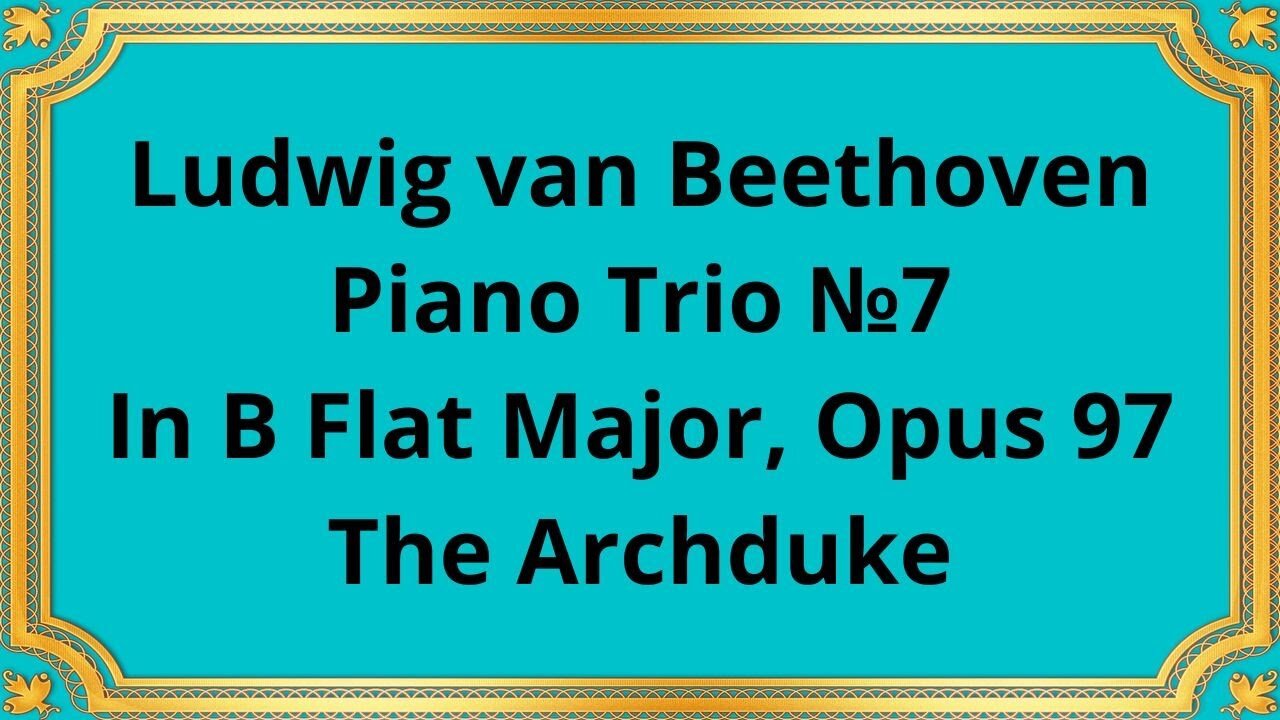Premium Only Content

Ludwig van Beethoven Piano Trio №7 In B Flat Major, Opus 97 The Archduke
#LudwigvanBeethoven #PianoTrio #ClassicalMusic #MusicalComposition #ChamberMusic #BFlatMajor #Opus97 #TheArchduke #ClassicalComposer #RomanticEra
THE LOVERIDGE-MARTIN-HOOTON TRIO
Iris Loveridge, piano; David Martin, violin:
Florence Hooton, cello
Ludwig van Beethoven, a towering figure in the world of classical music, has left an indelible mark on the musical landscape with his masterful compositions. Among his extensive repertoire, the Piano Trio No. 7 in B Flat Major, Opus 97, commonly known as "The Archduke," stands as a testament to his genius.
Composed in 1811, Beethoven's Piano Trio No. 7, Opus 97, emerged during the Romantic era, a period marked by musical exploration and emotional expression. This trio was dedicated to Beethoven's friend and patron, Archduke Rudolf of Austria, hence its popular nickname, "The Archduke." As Beethoven's final completed piano trio, it represents the culmination of his mastery in the genre.
The Piano Trio No. 7 in B Flat Major is structured into four movements, adhering to the classical tradition of the piano trio genre. The first movement, marked Allegro moderato, opens with a majestic and triumphant theme that sets the tone for the entire composition. The second movement, Scherzo: Allegro, presents a lively and spirited dance-like character, followed by a contrasting lyrical trio section. The third movement, Andante cantabile ma però con moto, brings a sense of introspection and tenderness, captivating listeners with its heartfelt melodies. The final movement, Allegro moderato - Presto, encompasses a thrilling and energetic finale, showcasing Beethoven's mastery of dynamic contrasts and rhythmic complexity.
Beethoven's Piano Trio No. 7 delves deep into the realm of human emotions, traversing a wide range of moods and expressions. The opening movement exhibits a sense of grandeur and nobility, reflecting the dedication to the Archduke. The Scherzo movement brings a lively and playful spirit, while the Andante cantabile ma però con moto movement evokes a sense of longing and melancholy. The final movement, with its triumphant energy, leaves the listener with a sense of exhilaration and awe.
"The Archduke" Piano Trio holds a significant place in the chamber music repertoire, showcasing Beethoven's artistry and innovation. It stands as a testament to his ability to push the boundaries of musical form and expression. The trio's emotional depth, technical intricacies, and profound musicality have ensured its enduring legacy. It has inspired generations of musicians and composers, serving as a touchstone for future piano trios and chamber music compositions.
Conclusion:
Ludwig van Beethoven's Piano Trio No. 7 in B Flat Major, Opus 97 "The Archduke," represents a pinnacle of musical artistry and emotional depth. Its historical context, structural brilliance, and lasting impact on the chamber music genre make it a timeless masterpiece. As we immerse ourselves in the grandeur and emotional journey of this trio, we gain a deeper appreciation for Beethoven's genius and his profound influence on the evolution of classical music. "The Archduke" continues to captivate audiences and stands as a testament to the enduring power of Beethoven's music.
You have the opportunity to support the channel:
https://destream.net/live/RadSiarAl/donate
https://www.buymeacoffee.com/6355radsiaral
-
 34:26
34:26
Classical music_Music Inspiration
1 month agoAram Khachaturian Concerto for Violin and Orchestra
792 -
 1:37:26
1:37:26
The Officer Tatum
2 hours agoLIVE Rachel Maddow, Don Lemon MELTDOWN Over Joy Reid's FIRING! + More Ep 68
26.3K11 -
 LIVE
LIVE
The Gateway Pundit
1 hour agoEpstein & JFK Files BLOCKED: Luna’s SHOCKING Clash with Pam Bondi! | Elijah Schaffer & Jim Hoft
2,093 watching -
![[Ep 616] Colony Ridge History & Raids | Guest: Elsa Kurt | Crenshaw Unhinged – Wants to Kill Tucker](https://1a-1791.com/video/fwe1/4d/s8/1/K/3/M/j/K3Mjy.0kob-small-Ep-616-Colony-Ridge-History.jpg) LIVE
LIVE
The Nunn Report - w/ Dan Nunn
1 hour ago[Ep 616] Colony Ridge History & Raids | Guest: Elsa Kurt | Crenshaw Unhinged – Wants to Kill Tucker
316 watching -
 2:03:21
2:03:21
The Quartering
3 hours agoDan Crenshaw Hot Mic Threat, Jake Paul Endorses Vivek, and Kathleen Kennedy Leaves Lucasfilm
47.7K20 -
 5:10:45
5:10:45
Viss
5 hours ago🔴LIVE - Precision Guided & Strategic PUBG Tactics!
14.1K2 -
 1:06:58
1:06:58
The White House
3 hours agoPress Secretary Karoline Leavitt Briefs Members of the Media, Feb. 25, 2025
43.8K26 -
 1:34:46
1:34:46
Russell Brand
4 hours agoControl Slipping: Germany’s Vote, Ukraine, Apple, and Joy Reid – SF543
96.2K27 -
 57:44
57:44
Winston Marshall
4 hours ago“They Were Hiding THIS!” Michael Shellenberger UNCOVERS Dark Secret About USAID and The Deep State
39.2K17 -
 50:59
50:59
Michael Franzese
1 day agoAmerica’s Biggest Issues EXPOSED by Tomi Lahren
60.2K13